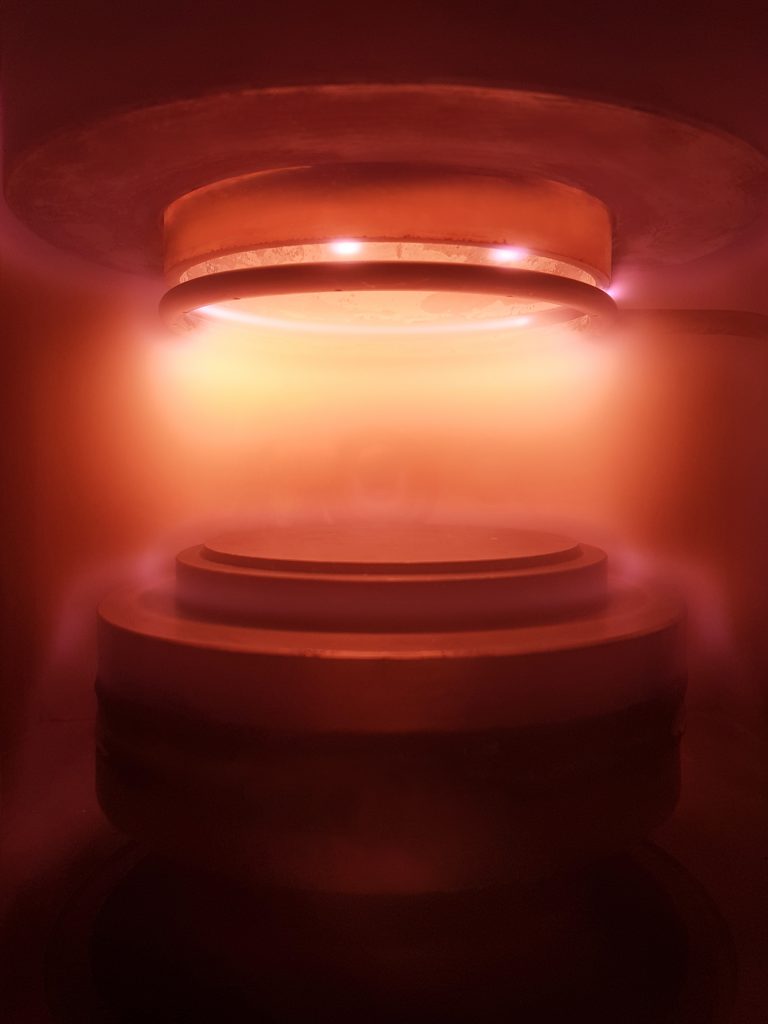Electron Cyclotron Resonance (ECR) is an advanced excitation method used in plasma engineering. The underlying principle of ECR is explained by Lorentz force; a combination of both electric and magnetic forces induced by applied magnetic fields. Free electrons in a high magnetic field environment will rotate with a uniform frequency. This electromagnetic force is generally proportional to the excitation frequency of the magnetic field.
A second key aspect of ECR for plasma engineering is the introduction of a gas volume ignited by microwaves. This is injected into the magnetically-shielded chamber at a frequency that corresponds to the ECR. The microwave frequency and electron cyclotron frequency subsequently resonate, energising free electrons within the gas and causing partial ionisation which results in a glow discharge. This process is essential for a broad range of plasma engineering applications, including chemical vapour deposition (CVD).

Benefits of ECR Plasma Engineering
Plasma-enhanced CVD (PECVD) is one of the leading thin-film deposition techniques currently available, allowing unparalleled levels of control over the elemental composition of a deposited thin film. PECVD reactors are characterised by high-density plasmas responsible for the generation of structures with high-energy chemical bonding states. This reduces the reliance on excessive heating of substrates and deposition targets, enabling the formation of low-temperature deposited films. Consequently, ECR plasma engineering has emerged as the ideal tool for advanced manufacturing of micro- and optoelectronics.
ECR PECVD enables the generation of silicon dioxide (SiO2), silicion nitride (SixNy), and silicon oxynitride (SiOxNy) on sensitive electronic components at safe temperatures. Conventional CVD techniques require substrates to be heated to a degree that would be detrimental to the stability of microelectronics. For example: silicon nitride formation typically occurs at temperatures of approximately 850°C (1562°F). This would destroy integrated circuits, rendering the technology non-viable for microelectronic applications.
ECR PECVD can facilitate the formation of silicon nitride on substrates at temperatures of just 350°C (662°F). ECR plasma engineering is consequently the ideal tool for manufacturing advanced ICs, and optoelectronic components. However, the unique chemical instability of this high energy process has been considered detrimental to microelectronics due to concerns that it leads to poor control of the end-product’s physiological properties. Robust plasma diagnostics are essential therefore in ensuring fidelity of deposited thin films.
ECR Plasma Engineering with Hiden Analytical
Hiden Analytical is the UK’s leading supplier of quadrupole mass spectrometers for advanced process development, process monitoring and research applications. We have developed a suite of solutions that can withstand the challenging operating environments of plasma engineering, facilitating the most accurate in situ analysis of plasma neutrals, radicals, positive and negative ions from ECR ion sources currently available. Plasma ion analysis is vital for optimisation of the ECR plasma process and for process development. This is an essential factor that underlies the success of advanced ECR PECVD manufacturing. Hiden offers a choice of plasma probes designed to measure key plasma parameters in real time, providing precise and reliable information pertaining to reaction chemistry in ECR-enhanced deposition chambers.
Both the EQP Series and PSM Mass/Energy Analyser are equipped with magnetic shielding which enables them to withstand the electromagnetic field generated by ECR plates or coils. Each of these innovative tools provides a detailed understanding of the reaction kinetics of plasma ions and neutral species, which are instrumental in the reduced deposition temperature of PECVD.
If you would like to learn more about ECR, and how Hiden Analytical can assist in your plasma engineering diagnostics, please do not hesitate to contact a member of the team today.
[Source: Science Direct]

